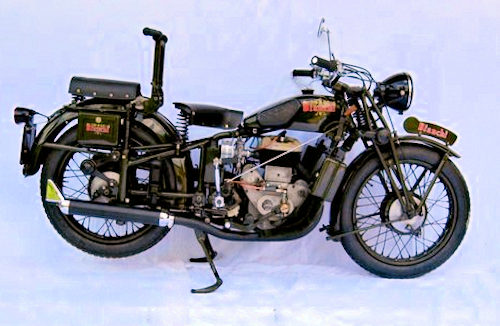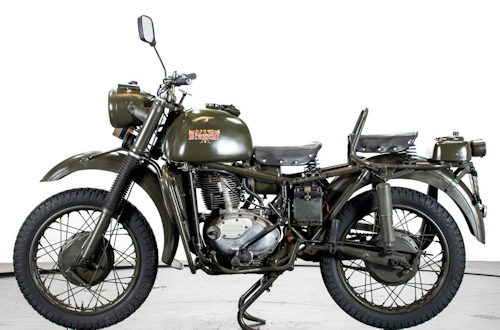The history of motorcycles in the Royal Army is not easy to reconstruct because in general information on the first massive motorization of the armed forces is scarce. There is a lack of testimonies and the most reliable news are inevitably those that come from collectors and some manufacturers.
It must also be said that in the early years of the last century the same bicycles were a novelty: several soldiers took some time to learn how to use them. Let's not talk about motorcycles; although official motorcycle competitions were held as early as 1911, the motorcycles of the time were really complex to drive, full of levers, regulators and procedures to drive them and the standard armament and luggage certainly did not favor handling.
The Bianchi
Initially, when it manufactured only bicycles, the company founded by Edoardo Bianchi in Milan was called FIV (Fabbrica Italiana Velocipedi). With the First World War, Bianchi became the first supplier of single and twin-cylinder motorcycles and sidecars, also producing armored cars, multipurpose chassis (bus trucks) and cars until the 40s before closing the motor industry in 64.
Bianchi C75, 500 M and MT61
The Bianchi C75 is the first Bianchi 500 cc (1915) to establish itself on a military level after the so-called “motorcycle” of the Milanese manufacturer, in type very similar to the first Frera. On the handlebar was fixed the accelerator lever (without spring return) and that of the advance to be modified with increasing rpm. The front brake did not exist and was braked only with the rear using the manual gearbox. Also in the C75 there was the pump to distribute the oil to the engine.
 With the 500M a radical change takes place, at least in terms of image, being absolutely more like a motorcycle than a bicycle.
With the 500M a radical change takes place, at least in terms of image, being absolutely more like a motorcycle than a bicycle.
The letter "M" as you can imagine means military since it is a motor vehicle built according to the directives of the Royal Army. (The history and technical information are taken from Davide Zendri "The collection of military motorcycles of the Italian historical war museum".)
The 500M also had a lever throttle and manual advance and hand shift, but could run at idle in order to flank troops on foot. The dexterity on the levers was fundamental, in addition to everything else, and it was not uncommon to make changes without having brought the throttle lever to a minimum.
From an indiscretion it emerges that, in addition to the dark green and black colors for the militia, there were added the desert ones produced for the AOI mission in Italian East Africa and the red ones destined for the Russian front rather than for the occupation in Albania in '39.
The Bianchi 500 M series was assigned to the Bersaglieri motorcyclists and to the cavalry and was robust and easy to maintain, but in the civil field it did not have a great response.
The novelty arrived in '37, when Bianchi created the first amphibious motorcycle by raising the duck neck exhaust above the saddle and inserting the battery under the saddle and with a height of 70 mm that allowed the soldiers to put their feet on the ground .
 With the arrival of the MT61, or the tactical motorcycle, one has the impression of being in front of an enduro prototype. The muffler followed a final duck-neck line rising back up to the saddle and the electrical system was waterproofed to allow immersion up to almost half a meter. The 498 cm³ twin-shaft engines had a range of 360km. Probably the war context had favored some form of collaboration between Bianchi and Moto Guzzi.
With the arrival of the MT61, or the tactical motorcycle, one has the impression of being in front of an enduro prototype. The muffler followed a final duck-neck line rising back up to the saddle and the electrical system was waterproofed to allow immersion up to almost half a meter. The 498 cm³ twin-shaft engines had a range of 360km. Probably the war context had favored some form of collaboration between Bianchi and Moto Guzzi.
I read that military motorcycles could also work without a battery. It was enough to connect the ignition coil to the flywheel magnet (as on mopeds); the battery, if present, received its normal recharge.
Curiosity: a characteristic of our Italian military motorcycles was the inverted sidecar, the Italian one was on the left of the bike.
Gilera 500 LTE
Also in Lombardy in Arcore the Gilera workshops produced in '37 a single cylinder of 500 cm³ for the gunners, but before describing the main aspects you will have noticed (excluding the type of motorized bikes) that the displacements were almost all of 500 cm³. Without prejudice to the technological limits of the period, the greater simplicity of producing a single-cylinder and the rapidity of production played a crucial role in the war period, as did the weights that rewarded the engines with a piston which had to generate a satisfactory torque.

So the single-cylinder had to somehow fulfill the task of a two-cylinder that was certainly more stable in terms of performance, a concept that is also summed up in the characteristics (sub-square, square and super-square engines) of bore and stroke of the cylinders, length of the connecting rods. and crankshaft gooseneck.
By increasing the number of cylinders, two phenomena in terms of performance substantially occur: the piston shortens its stroke (pmi-pms) and its speed decreases (less vibrations and overheating) by reducing the cylinders (one cylinder), at the same speed, the engine can run at higher revs (more sprint); power is related to the rotation of the thruster.
In the military sector, a compromise was sought in the mono-cylinders to slow down the engine and offer greater mechanical longevity, torque and cooling.
I look at the data of the Gilera 500 LTE where the bore of 84 mm by 90 of stroke (similar measurement ratio) developed little power but a lot of torque. A feature of the military engines that Gilera also adopted is the adoption of side valves, but LTE, short for Side Valves and Elastic Frame, brought with it other innovations. He patented an integral elastic suspension for military use to tackle any uneven ground in synergy with his single-cradle steel frame.
In addition to the 500 LTE, the bike with bodywork is noteworthy Mars with cardan transmission and a transmission also on the wheel of the side car, a 3x2. The evolution after the second conflict was the Gilera Saturn, supplied to the reorganized Italian Army which had different performance characteristics compared to the civil version.
Benelli and military Sertum
The debut of the Pesaro-based company dates back to 1911 and the production is full of motorized bikes and many evolutions until 37, the year in which the 250 cc military M37 made its debut, a single-cylinder four-stroke tilted forward by 12 degrees, with cylinder and head. in cast iron with double pipe to which is added the 500 M36 motorcycle, in practice the first Light Multirole Vehicle Army.

The military motorcycles were different and almost all came from the national industry and, in the same department, there could be several brands in the same team for similar tasks, mostly reconnaissance. Among the bikes there was also the Milanese Sertum MCM 500, born in '22 in the Officine Meccaniche Fausto Alberti in Viale Certosa, the first Italian motorcycle to achieve a technical innovation in drum brakes.
The brakes
Mopeds at the beginning of the last century braked little and it took a lot of courage to compete in competitions. The first brakes were the bicycle buffer brakes, but insufficient to stop a heavier motorized bike. Then the band brake was tested, but it was the drum brake that offered the best compromise, even if in several examples it braked only the rear wheel. Initially the drive was by steel cable, then hydraulic with closed circuit.
It wasn't until 1969 that Honda presented the first hydraulically operated disc brake.
Hand and pedal change
The history of the gearbox in motorcycles is really troubled, but if you like to ride a motorbike you cannot give it up: only with the manual you do one body with the motorbike.
With the first chain drives of motorcycles, a clutch and at least three-speed gearbox appeared. Only the clutch lever was placed where it is today, although in some historic Harley-Davidson there was even a pedal on the left.
Next to the tank of our two-wheeled memorabilia, there was a knob that you gradually moved forward or backward (as in the Vespa Piaggio). With the evolution the movements became alternating, sequential, like the movement of the traditional pedal.
The pedal itself is the subject of confusion. Initially in Europe the gearbox was on the right with first at the top then, with the arrival of the Japanese market there was the conversion: gearbox on the left and first at the bottom, but for a long time there was a mixture of types that generated confusion even to the insiders. The right foot, as happens in a car, had to brake on the right also in motion. Since then, this Japanese philosophy has been the standard scheme. In short Japan docet.
Read the first part "The Army on two wheels: from bicycles to motorcycles"
Read the second part (bis) "The Army on 2 wheels: The success of motorbikes “Throbbing Irrrompo"
Read the third part: "The Army on 2 wheels: logistical roles for motorcycles"
Photo: web












